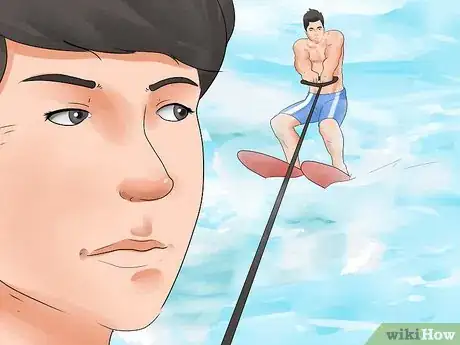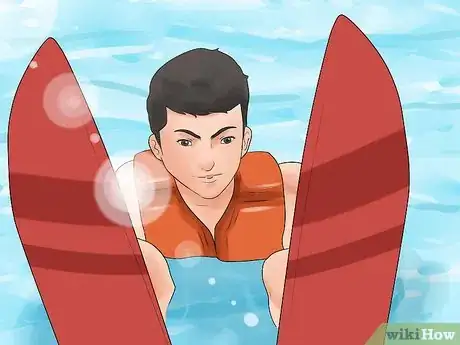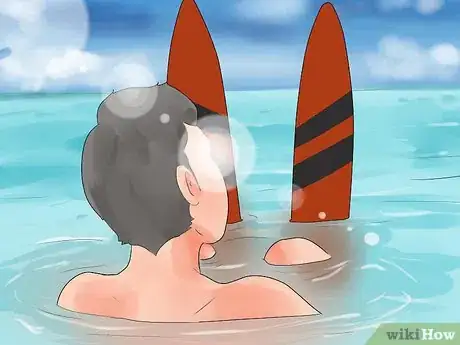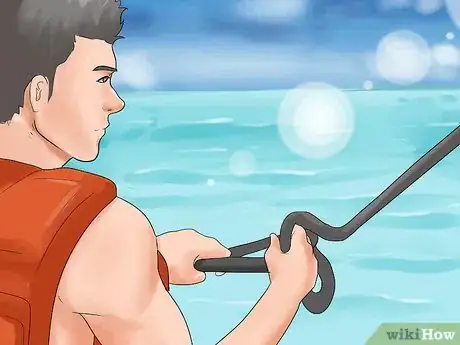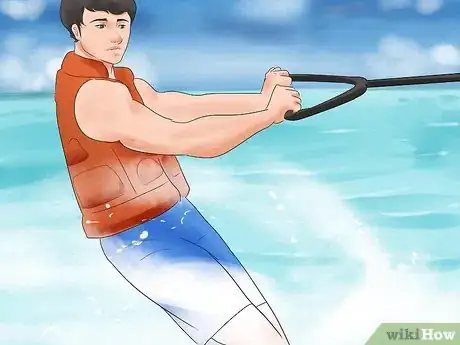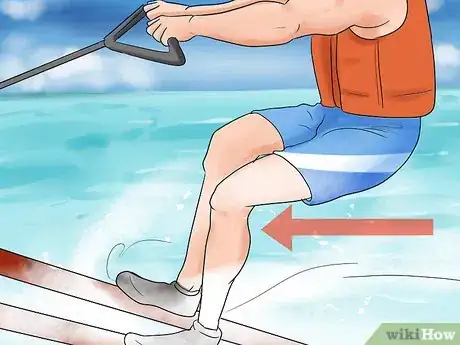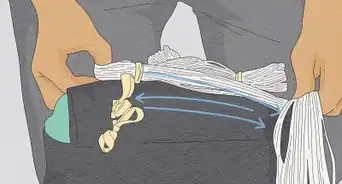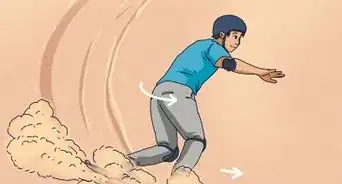wikiHow is a “wiki,” similar to Wikipedia, which means that many of our articles are co-written by multiple authors. To create this article, 12 people, some anonymous, worked to edit and improve it over time.
wikiHow marks an article as reader-approved once it receives enough positive feedback. In this case, 88% of readers who voted found the article helpful, earning it our reader-approved status.
This article has been viewed 150,974 times.
Learn more...
Have you ever seen someone water ski? Have you ever been fascinated by the way they seem to glide on the water effortlessly, and thought, "I want to do that?" With a few tips and proper preparation, you will have no trouble water skiing!
Steps
Preparing to Water Ski
-
1Wear a life vest. A proper personal flotation device should be a jacket or vest that covers the chest, stomach and back. The life vest must be properly fitted so that it does not slip up on the body when falling.[1]
- It should fit snugly but not be uncomfortable.
- Be sure to check the manufacturer’s label for weight limits and sizing information. [2]
-
2Obtain water skis. You will want a pair of combination skis, which are suitable for beginners and have two skis with one ski having a half-foot binding behind the other foot. Skis for beginners will usually be wider and thus more stable on the water. They will be made for different weight ranges so it is important to pick a water ski that suits your size.
- Check the manufacturer recommendations for the recommended weight ranges for the particular skis you are looking at.
- Kids skis are different in that they are smaller and easier for small children to control. They will usually come with a “trainer” option, or when you tie the skies together to prevent the skier from losing their balance and performing the splits.
- The bindings will usually be adjustable for a range of sizes to fit a variety of people.[3]
Advertisement -
3Consider tying the skis together. Trainer skis for kids can often be tied together, preventing the child from doing the “splits”. Kids usually have a hard time keeping control over their skis and keeping them together so this can be incredibly helpful when beginning.
-
4Use a proper water skiing rope. A water skiing rope will have a little stretch only and be 75 feet (22.86 meters) long from the handle to the opposite end. Do not use a wakeboarding rope, which will have no stretch, or a rope that is too stretchy.
- The rope should be labelled and marketed specifically for water skiing.
-
5Learn to use the proper signals. There are seven different hand signals that a skier should learn. These are important for signalling the boat driver while water skiing.[4]
- A thumbs-up means go faster while a thumbs-down means slow down. It is important to remember this while skiing so that you do not accidentally ask for more speed.
- Bring thumb and forefinger together to signal OK. This tells the driver that the speed and path are good.
- Point your finger in the air and move it in a circular motion and then point to the direction when you want to turn a certain way. This can be used by the water skier to signal that they want to go a particular way or by the boat driver to warn the skier of a turn.
- Pat your head to signal that you would like to return to the dock. You can do this if you are tired and want to finish.
- A slashing motion at the neck means to stop the boat immediately. This can be done by the skier, driver or observer in case of emergencies.
- Clasp your hands over your head after a fall to signal that you are OK. This should be done after every fall.[2]
-
6Get a ski flag for safety. Many states require boats to have ski flags. These are usually bright coloured flags that signal to other boats that there is a skier in the water. Every time the skier is in the water and not skiing, the flag must be held up for other boats to see.
- This is an important safety measure and most boats will need an observer who is in charge of watching the skier and holding the flag.[2]
-
7Learn the proper stance on dry land first. The proper stance for starting to water ski is called the “cannonball” position.[5]
- While on dry land, put the skis on your feet.
- Hold the handle and bend your knees so that you are sitting on the skis in the same form you would use to complete a cannonball.
- Have someone pull gently on the other end of the rope to help pull you up into into a chair position. You will look like you are sitting in a chair, even though there is not one.
- Make sure your knees stay together at all times and that you keep your arms straight to allow the rope to pull you up.[2]
Driving the Boat Properly
-
1Start quickly. The most important aspect of pulling a water skier is to start quickly, or have a lot of torque. This means that you must have a relatively strong boat and that you start from zero very quickly. This will help the water skier to get up on their skis smoothly.
-
2Pull steadily. It is very important that the driver pull steadily to ensure a smooth ride for the water skier. If they change speeds or turn suddenly it can be very difficult for a beginning water skier to maintain balance.
-
3Pick a time when the waters are calm. Usually early morning works best when water skiing because that is when the water is at its calmest. Later in the day there may be more traffic and thus rougher waters.
- If you do hit rough water or wakes, then you should hit them at a 90 degree angle to minimize the bumps for the water skier.
- It is important to make water skiing fun for kids so try to pick a time which is suitable for everyone when teaching them.
-
4Use the proper speed. Speeds will vary according to the size and experience level of the skier but there are general guidelines for water skiing. Kids should be pulled as slow as possible while keeping them out of the water. The speeds described here are for water skiing on two skis only.[6]
- Water skiers who are less than 50 lbs. (<23 kg) should be pulled at about 13 mph (21 km/h).
- Water skiers who are 50-100 lbs. (23-45 kg) should be pulled at about 16 mph (26 km/h).
- Water skiers who are 100-150 lbs. (45-68 kg) should be pulled at about 18 mph (29 km/h).
- Water skiers who are 150-180 lbs. (68-82 kg) should be pulled at about 21 mph (34 km/h).
- Water skiers who are more than 180 lbs. (>82 kg) should be pulled at about 24 mph (38 km/h).
- Adjust your speed on turns. If the skier is on the inside of a turn then they will slow down and you may need to speed up. If they are on the outside of the turn they may speed up and you may need to slow down.[2]
-
5Stay away from docks and the shore. You can easily slingshot a water skier on a turn so it is important to make sure that you keep far enough away from any docks or obstacles. Additionally, if a skier lets go they can travel quite far before sinking into the water so keep this in mind.
- Do not go over any shallow water or where there may be obstructions just above or below the surface of the water.
- Most ski accidents occur from collisions with docks or other solid objects so be very careful about staying in open water.[2]
-
6Make sure you can see the skier at all times. You should usually have an observer on the boat to help you watch the skier in case they fall or are signalling the boat. It will be difficult for the driver to watch where they are going and keep an eye on the skier at the same time.
- The observer will be the one controlling the ski flag and relaying signals to the driver.
-
7Turn off the propeller completely when picking up a fallen skier. It is always good practice and safer to turn off the propeller completely when near anyone in the water. As soon as you get close, turn off the propeller and let your momentum bring the boat alongside them.
- Be very careful not to injure the skier when bringing the boat near. Do not come too close and always turn off the propeller.
Getting Up on Water Skis
-
1Consider using an EZ ski trainer to help kids feel more comfortable. An EZ ski trainer helps kids get used to being pulled behind a boat before trying to get them up on water skis. This device is like an inflatable jet ski that will be pulled behind a boat on a rope. It also helps kids build confidence, learn how to hold the hand and maintain balance.
- The kids can sit or stand as they feel comfortable, learning how to balance and getting accustomed to being pulled behind a boat.
- Be patient with kids and allow them to go at their own pace. This trainer can help reduce some of their nervousness before water skiing.[2]
-
2Put the water skis on your feet. Sit on the side of the boat or at the dock and put the water skis on. They should be adjusted for your correct size and you will usually simply have to slip your feet inside to secure them. The foot should be tight so it may take a little wiggling to get your feet in all the way.
- It can help to wet the skis before putting them on, because it makes them easier to slide on your feet.
- Kids may need assistance with getting their skis on properly so help them when necessary.
-
3Grip the rope securely with your hands. Hold the rope with your two hands next to each other. Both palms should be facing down for water skiing on two skis. Make sure your grip is secure and your arms stick straight out in front of you.[2]
-
4Pull your knees to your chest, with your arms around your knees and the rope between the skis. Allow your personal flotation device or lifejacket to keep you on top of the water and lean back. Bring your knees to your chest, with your arms around the outsides of your knees as if you are hugging them.
- Bring the rope in between the tips of your skis with the handle between your body and the ski tips.
-
5Keep your skis pointing straight forward, close together with the tips pointing up. While leaning back with your knees to your chest, bring your ski tips up out of the water, keeping your skis straight and close together. Water skis should be no more than hip width apart.
- Kids skis will often have a rope or other device holding them together. This helps keep their skis together to maintain control.
-
6Keep your arms straight so that the boat pulls you out of the water. With the rope between your skis and your hands holding the handle securely between your body and the ski tips, keep your arms straight in front of you. This is a very important aspect of getting up on water skis.
- It is very important to let the boat pull you out of the water and up onto your skis.
- If you try to bend your arms or pull yourself up out of the water, you will likely lose your balance and fall.
-
7Consider having someone holding you while you wait for extra balance. If you are close to shore, someone can hold the water skier in their arms, keeping their skis together and helping them to balance while leaning back with their knees to their chest.
- This can be especially helpful for children, who may lose their balance or form while waiting for the boat to go.
-
8Make sure the rope is tight before starting. There cannot be any slack in the rope with the boat starts going or else it will jerk the water skier forward and cause them to lose their balance. Once the rope is in the water skier’s hands the boat can move forward at a slow pace until the rope is tight.
- The water skier may move slightly forward through the water while the rope is being tightened. Be careful to stay balanced and maintain your form.
-
9Tell the driver to “hit it” to start the boat. Yell “hit it!” to the driver to signal that you are ready to begin. The boat will start quickly forward. Keep your form together and stay calm and confidence. Being confident and relaxed is very important for getting up easily on water skis.
- It is more important that the boat has a lot of torque, or picks up speed quickly, rather than that it achieves a high speed.[2]
-
10Lean back and let the boat pull you up. Keep your ‘cannonball’ form while leaning back slightly with your arms straight in front of you as you allow the boat to pull you up. The skis should be directly underneath you even though you are leaning back slightly. Do not stand up immediately.[7]
- Bending your arms to pull yourself up will only cause you to lose your balance so keep them straight.
- Keep your eyes directly ahead. Putting your eyes and head up to avoid splash can make you lose your balance while looking down will likely cause you to fall down.
-
11Keep your knees bent. Having your knees bent is imperative both before the boat starts and while you are trying to get up on skis. This will help you to maintain balance properly and better control your skis.
- Even if the water is quite smooth, there will always be small bumps so keeping your knees bent will help to absorb those bumps.
-
12Stand up only after you are comfortable and balanced while being towed behind the boat. If you are comfortable being pulled and are balanced, try standing up. While standing keep your feet and skis directly beneath you and simply straighten out your legs while continuing to lean back slightly with your arms directly in front of you.
- It might be best for kids to try skiing once or twice while remaining in the ‘cannonball’ form the entire time. This helps them to get used to water skiing and maintaining balance and control.
-
13Try again if you fall the first time. It can be tricky to keep your balance while learning how to water ski. Be patient with yourself and keep your confidence. If you are getting frustrated you can give yourself a break and try again later.
- Covering your face with your hands when you float back up to the surface can help prevent you from getting banged in the face by the ski if it falls off.
- Hold up your arm or a water ski while the boat and turning to come back to you so that other boaters can see you and avoid you.
Staying Up on Water Skis
-
1Keep your knees bent at all times. Bending your knees will help you to absorb any bumps or wakes that the boat traverses, helping you maintain balance and continue standing.
-
2Keep your arms straight, letting the boat pull you forward. Do not try to pull yourself forward or maintain balance by pulling on the rope. You should simply allow the rope to continue pulling you forward.
-
3Lean back at all times to maintain proper positioning. Lean back slightly with your hips forming a straight line with your shoulders. You can push your hips slightly forward and up towards the handle but make sure the skis stay directly beneath you.
- Allowing the skis to move to far out in front of you will cause you to fall backwards.
- Leaning forward will cause the skis to move behind you and make you fall forward. [2]
-
4Breathe naturally. Many skiers tend to hold their breaths while skiing but it is important to breathe naturally. Normal breathing will reduce fatigue and prevent you from getting overly tired.
-
5Try turning slightly once you are comfortable skiing straight forward. Try turning slightly by putting more pressure on the inside edge of the ski on the opposite side of where you want to go. Stay inside the wake for now.
- For example, you will push down on the inside edge of the ski with your left leg and lean slightly to the right and away from the boat to move to the right. At the same time you can lift up slightly with your right foot to help you turn.
- Make sure you keep proper positioning with your knees bent and arms straight in front of you while you turn.[2]
-
6Attempt to go outside the wake once you are comfortable turning within the wake. Make a turn to either side and cross the wakes by turning your skis at a sharp angle to the wake. Keep pressure on your ski closest to the boat until you are completely outside the wake.
- Keep your knees bent to absorb the shock.
- If you try to cross with one ski at a time, you will fall. Make sure you cross at a sharp angle to the wake with both skis at the same time.
- Going over the wake should be quite quick. If you try to go slowly, you will fall.
- Keep your arms straight in front of you while crossing the wake. Pulling on the handle is a common mistake made by beginners and can also cause you to lose your balance and fall.[2]
Warnings
- Make sure the motor is off when a skier is entering or exiting the boat.⧼thumbs_response⧽
- Always have an observer in the boat in case of falls or important signals.⧼thumbs_response⧽
- Always wear a personal flotation device and make sure your equipment is in good condition.⧼thumbs_response⧽
- Stay away from docks and other solid objects when skiing.⧼thumbs_response⧽
- Never ski directly in front of a boat.⧼thumbs_response⧽
References
- ↑ https://www.usawaterski.org/BasicSkills/LearnToSkiBasics.pdf
- ↑ 2.002.012.022.032.042.052.062.072.082.092.102.11 http://www.usawaterski.org/basicskills/learntoskibasics.pdf
- ↑ http://www.ebay.com/gds/Your-Guide-to-Buying-Water-Skis-/10000000177636189/g.html
- ↑ https://www.usawaterski.org/BasicSkills/LearnToSkiBasics.pdf
- ↑ https://www.boatingmag.com/teaching-others-how-to-water-ski#page-4
- ↑ https://www.boatingmag.com/teaching-others-how-to-water-ski#page-5
- ↑ https://www.theguardian.com/lifeandstyle/2007/jun/23/healthandwellbeing.features5
About This Article
To water ski on two skis, start by getting a pair of skis suitable for beginners, such as combination skis, which are wider and more stable on the water. Additionally, check the manufacturer’s recommended weight ranges to ensure you buy the right skis for your size. When you’re ready to ski, sit in the water with your knees pulled to your chest and bring your ski tips out of the water. Then, place the rope between your skis, hold it with both hands, and allow the boat to pull you out of the water. For more tips, like how to practice the proper stance on dry land before getting in the water, read on!











